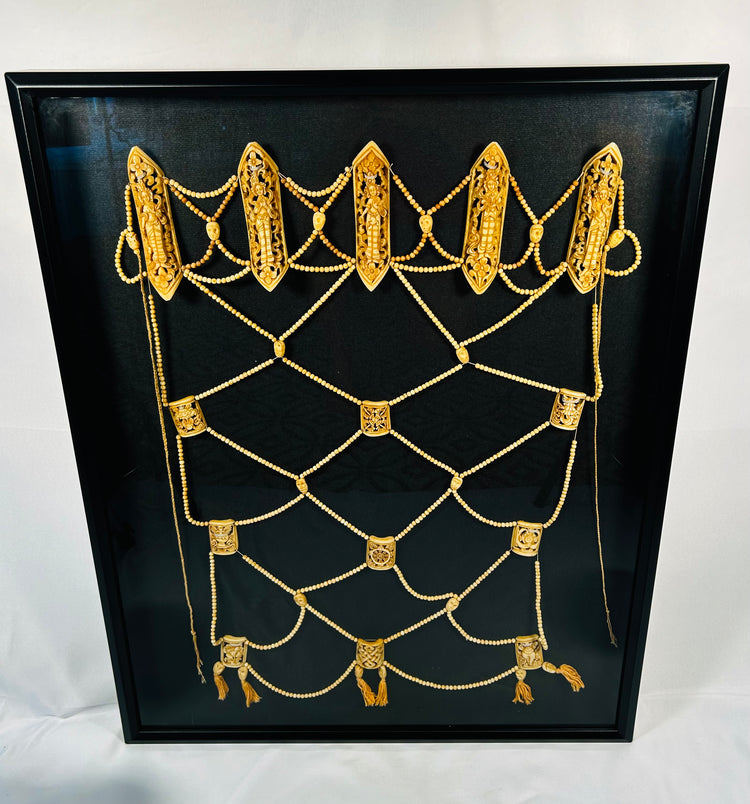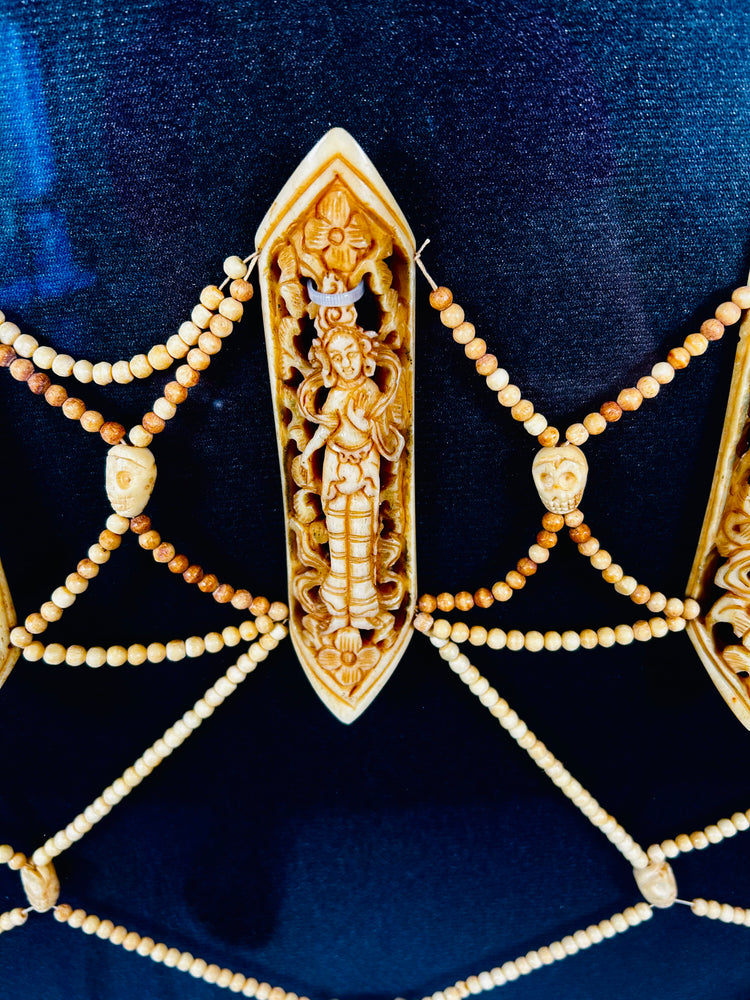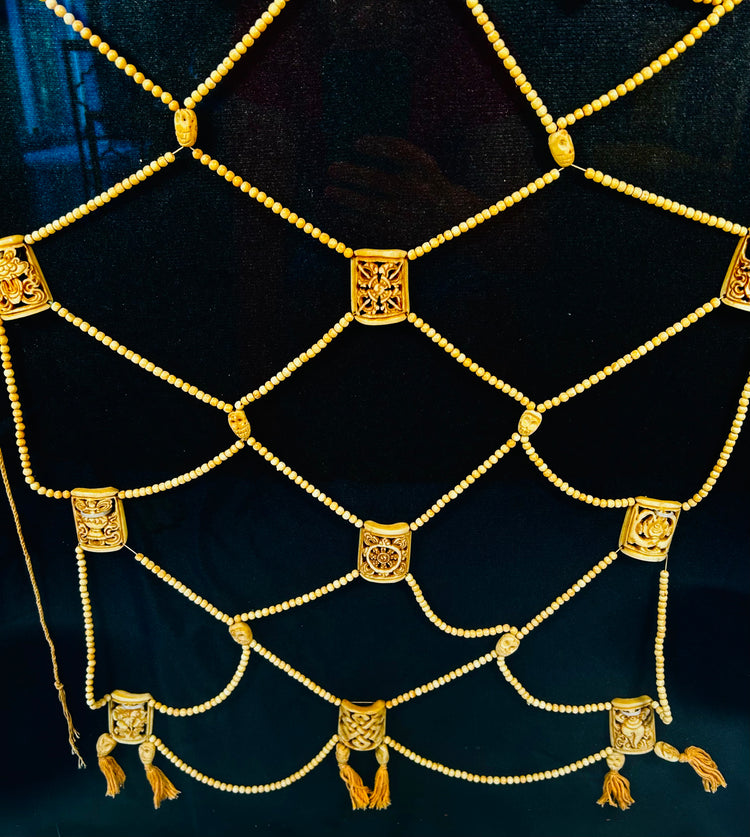Tibetan Tantric Ritual Apron (Rus Gyan) | Human & Animal Bone with Deity Carvings | 19th Century
Description
More
Less
Historical Context & Origin
Region: Tibet, Himalayan Region
Material: Human and animal bone, cotton backing, natural pigments
Period: 19th Century
Description
This extraordinary Tibetan Tantric ritual apron (rus gyan) represents one of the most sacred and esoteric forms of Himalayan Buddhist art. Crafted from human and animal bone, this ceremonial garment was worn by advanced Tantric practitioners during Chakrasamvara and cemetery rituals to symbolize impermanence, divine power, and spiritual transformation.
Six meticulously carved elliptical plaques depict wrathful deities (Heruka figures) surrounded by intricate bone beadwork and cotton strapping. The geometric lattice of bone spacers and beads forms an ornate network across the surface, combining sacred symbolism with the highest craftsmanship of 19th-century Tibet.
Features
- Authentic 19th-century Tibetan Tantric ritual apron (rus gyan)
- Six carved Heruka or Chakrasamvara deities on bone plaques
- Hand-carved human and animal bone beads in complex latticework
- Cotton cloth backing, aged but intact from ceremonial use
- Rich natural patina attesting to genuine ritual age and use
- Symbolic reference to mortality, transformation, and enlightenment
Cultural & Ritual Significance
These aprons were sacred vestments of Tantric Buddhist priests and practitioners engaged in advanced esoteric meditation. The use of human bone invoked awareness of death and rebirth, while the iconography of fierce protector deities embodied wisdom overcoming ignorance. Within the Chakrasamvara tantric system, the rus gyan served as both an instrument of ritual invocation and a marker of spiritual mastery. Today, such pieces are revered as rare Himalayan relics blending art, devotion, and profound metaphysical meaning.
Condition
Excellent preservation for its age. Surface wear, accretions, and patina consistent with centuries-old ritual use. Bone plaques and beadwork remain stable; cotton backing shows minor age-related fraying but remains intact. A powerful and authentic example of Himalayan Buddhist ritual art suitable for museum or private collection display.
Dimensions (approximate)
Height: 31 in
Width: 25 in
Depth: 2.5 in
Age
19th Century, Tibetan/Himalayan Tantric Buddhist Tradition
Learn More
Explore Our Blog: 19th-Century Tibetan Bone Apron – Tantric Sacred Art
View a Similar Example at the Rubin Museum of Himalayan Art: Bone Apron
Read More About These Sacred Items at Himalayan Art Resources: Ritual Objects: Bone Aprons
Description
Historical Context & Origin
Region: Tibet, Himalayan Region
Material: Human and animal bone, cotton backing, natural pigments
Period: 19th Century
Description
This extraordinary Tibetan Tantric ritual apron (rus gyan) represents one of the most sacred and esoteric forms of Himalayan Buddhist art. Crafted from human and animal bone, this ceremonial garment was worn by advanced Tantric practitioners during Chakrasamvara and cemetery rituals to symbolize impermanence, divine power, and spiritual transformation.
Six meticulously carved elliptical plaques depict wrathful deities (Heruka figures) surrounded by intricate bone beadwork and cotton strapping. The geometric lattice of bone spacers and beads forms an ornate network across the surface, combining sacred symbolism with the highest craftsmanship of 19th-century Tibet.
Features
- Authentic 19th-century Tibetan Tantric ritual apron (rus gyan)
- Six carved Heruka or Chakrasamvara deities on bone plaques
- Hand-carved human and animal bone beads in complex latticework
- Cotton cloth backing, aged but intact from ceremonial use
- Rich natural patina attesting to genuine ritual age and use
- Symbolic reference to mortality, transformation, and enlightenment
Cultural & Ritual Significance
These aprons were sacred vestments of Tantric Buddhist priests and practitioners engaged in advanced esoteric meditation. The use of human bone invoked awareness of death and rebirth, while the iconography of fierce protector deities embodied wisdom overcoming ignorance. Within the Chakrasamvara tantric system, the rus gyan served as both an instrument of ritual invocation and a marker of spiritual mastery. Today, such pieces are revered as rare Himalayan relics blending art, devotion, and profound metaphysical meaning.
Condition
Excellent preservation for its age. Surface wear, accretions, and patina consistent with centuries-old ritual use. Bone plaques and beadwork remain stable; cotton backing shows minor age-related fraying but remains intact. A powerful and authentic example of Himalayan Buddhist ritual art suitable for museum or private collection display.
Dimensions (approximate)
Height: 31 in
Width: 25 in
Depth: 2.5 in
Age
19th Century, Tibetan/Himalayan Tantric Buddhist Tradition
Learn More
Explore Our Blog: 19th-Century Tibetan Bone Apron – Tantric Sacred Art
View a Similar Example at the Rubin Museum of Himalayan Art: Bone Apron
Read More About These Sacred Items at Himalayan Art Resources: Ritual Objects: Bone Aprons
You May Also Like































